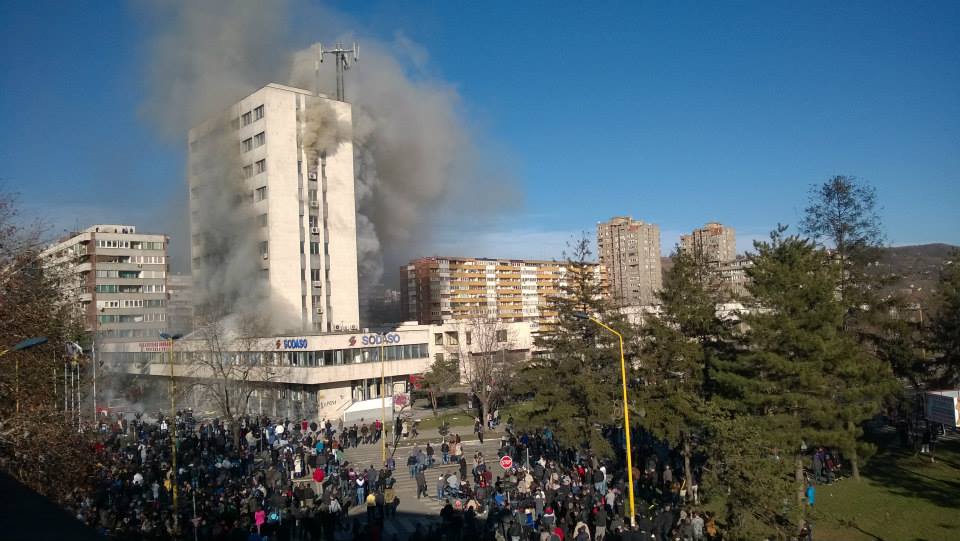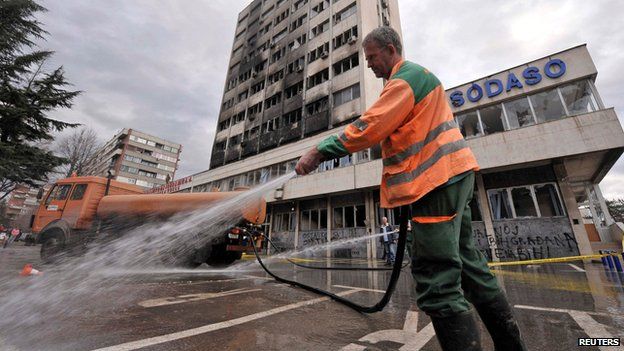The 2014 unrest in Bosnia and Herzegovina was a series of demonstrations and riots that began in the northern town of Tuzla on 4 February 2014, but quickly spread to multiple cities in Bosnia and Herzegovina, including Sarajevo, Zenica, Mostar, Jajce, and Brčko, among others, for social reasons and with the aim of overthrowing the government. The riots were the most violent scenes the country had seen since the end of the Bosnian War in 1995. The rioting largely took place in the entity of Federation of Bosnia and Herzegovina, and did not see the same level of unrest or activism in Republika Srpska.
Some news sources, such as BBC and the New York Times, used the name Bosnian Spring when describing the riots, a terminology taken from other events such the Arab Spring and the Prague Spring. The Swedish politician Carl Bildt also said that "in some places there has been talk about a Bosnian Spring".
Most of the riots calmed down by 8 February, although protesting continued throughout the days that followed.
By April 2014, the protests had faded away due to decreasing participation. A Balkan Insight article said they "ran out of steam"
4–5 February

Protests began on 4 February 2014 peacefully in the city of Tuzla, Bosnia and Herzegovina but turned violent the following day when hundreds of demonstrators, mostly former employees of several big companies, such as Dita, Polihem, Guming and Konjuh, clashed with police near the Tuzla local government building demanding for compensation and called on Tuzla officials to intervene instantly. Demonstrators blame local officials for allowing several state firms to collapse between 2000 and 2008 after being privatized, leaving many unemployed.
The protests later spread to various cities across Bosnia and Herzegovina, including Bihać, Mostar, Zenica, Kakanj and the capital Sarajevo.
Due to the recent closures of factories and firms in Tuzla, at least 600 protesters tried to storm the building of the Tuzla local government, accusing authorities of turning a blind eye to the collapse of a number of state firms after their privatization. Some of the protesters threw eggs, flares and stones at the windows of the building and set tires on fire, blocking traffic in the city center. Police eventually forced demonstrators back and cordoned off the building. One of the hundreds of protesters in the city said: "This is the start of the Bosnian Spring," alluding to the ongoing Arab Spring which began in 2010.
The protesters gathered in front of the cantonal government building, requesting for compensation and repayments of healthcare and pensions payments after the privatized companies for which they worked failed. Local media reports said that some protesters scuffled with police after breaking into the cantonal government building, while others set garbage containers and tires on fire. It is reported that in the end of the day, a total of twenty-two people, including 17 police officers, were injured, while 24 are arrested for their involvement in the protests.
As a result of the police brutality the day before, protesters were outraged. The next day, the number of protesters grew enormously; around 6,000 individuals gathered in front of the cantonal government building. The number of injured individuals rose enormously. According to local newspapers, around 100 policemen were injured, where the most of the injuries were from being hit by stones. 11 cars were destroyed and 27 protesters were arrested. Around 20 civilians had minor injuries.
6 February
On Thursday, 6 February the protests spread into multiple cities in the country, at first by people who wanted to show solidarity with the citizens of Tuzla; In the capital city Sarajevo, protesters clashed with police who had blocked traffic in the city center. Four officers were hospitalized. Over 200 people blocked traffic in Mostar and about 150 Zenica citizens protested in front of their local government building. One of the protestors in Zenica was quoted: "Today we fought for Tuzla, tomorrow we fight for all of us."Protests also broke out in Bihać and Tešanj, among others.
27 people who had been arrested the day before were released. That day also marked the first time since the start of the uprising that police used tear gas on the crowds, More than two dozen people were hospitalized with tear gas-related injuries.
Schools throughout Tuzla were closed and residents of buildings yelled insults and threw buckets of water at the officers who passed by in full riot gear. Elderly neighbors banged on their windows and balconies.
7 February


On 7 February, mass crowds began to gather at the same place and in over 20 major cities across the country. People gathered at their city centers to support protests in Tuzla. According to the official statements, more than 130 people, including 104 police officers, were injured on on the third day of anti-government demonstrations in Tuzla alone. After a long day of waiting, 10,000 outraged protesters broke the last line of police defense in the cantonal government building. Around 100 younger protesters stormed into the building throwing furniture and papers out of the windows, burning the whole building afterwards.

Even a quick intervention of the local firemen crew couldn't prevent the fire from spreading on other floors. The protesters gave them a "calm hour" after which the protests were carried in front of the cantonal court. Protesters asked workers of the cantonal court to address them about their plans in freeing the remaining protesters arrested that day and the day before, which included the leader and organizer of the demonstrations. Shortly after a rain of stones started hitting the cantonal court. The group of 10,000 people started moving towards the municipal building where all workers were evacuated before the angry mob arrived. The attack on the municipal building included a few short fights between the protesters and the special police units. It included using tear-gas which outraged the protesters even more. After the police fell back, protesters started throwing bricks and stones at the building, breaking every single window on it and burning it down afterwards. Shortly after burning the municipal building it was announced that the police forces have switched sides and joined the protesters.
During the unrest on Friday, 7 February, the mayor of Brčko was taken hostage by the crowd for a short while and then released.
In the afternoon, a unit of special police of the Tuzla canton under the commanding officer Dževad Korman lowered their shields and took off their helmets, which caused a wave of enthusiasm from the crowd, which was approaching and shaking hands with the special forces members. Both the regular and the judicial police did a similar thing in front of the Court and the Prosecution buildings.
8 February

Throughout 8 February the riots had stopped and all the people had resumed peaceful protests and begun clearing the streets of garbage and debris.


https://www.youtube.com/watch?v=UQpwdxwK0fQ